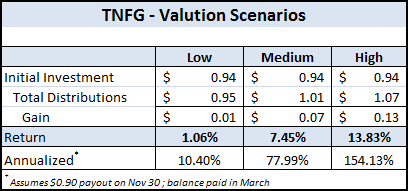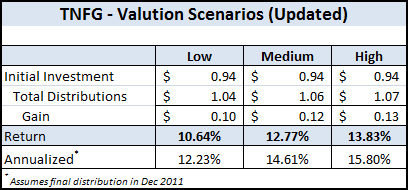Sparton Corp. (SPA) reported fiscal 2nd quarter results two weeks ago. The stock dropped sharply on the news, but has since rebounded. A great deal has occurred since my original post on the company.
SPA’s management continues to focus on improving margins and eliminating unprofitable contracts, so the fall in top-line results is probably expected – and sets the company up for a much better future.
Financial Results
Sparton reported results for the fiscal 2nd quarter of 2011, with sales falling from $47.2m to $46.3m, or 1.9%. The company showed top-line weakness across most of the major product divisions including foreign sonobuoy sales in the DSS segment and increased program losses within the EMS segment.
However, the Delphi acquisition has proved profitable, contributing $11.4m in sales on a net income rate of $1.2m, a major boost to the quarter’s final tally.
Operating profits were up 3% to $1.58m compared to $1.48m in the prior year quarter. The 2010 second quarter was negatively impacted by a $1m restructuring charge, but helped by a $1.9m income tax benefit, making bottom line comparisons difficult.
Overall, the company reported net income of $1.4m, or $0.14 per share.
Through the first six months of the year, sales are off 3% with significant declines in the EMS business offset by revenue increases in the Medical segment.
Operating income is much improved, even discounting for a $2.4m gain due to the recent acquisition, up to $5.6m.
The balance sheet remains strong, with $30m in cash offset by only $1.8m in debt (and the company has an unused $20m credit line available).
Business Segment Overview
Since taking over, management has been extremely focused on improving margins in the company’s core businesses. Some of the legacy contracts in the EMS division were unprofitable, and the company has made the difficult decision to cut loose or restructure contracts with those customers, causing the sales decrease.
Long-term, this is a sound strategy, as the remaining customer relationships will translate into higher margins, a key portion of the original investment thesis.
In addition, the legacy Medical business segment has shown declines over the past few quarters, due to softening in several core customers. According to Cary Wood, Sparton’s CEO:
“there have been three major customer issues that have primarily impacted the overall softening, with one customer that suspended production to make product enhancement modifications, a second customer who moved their production back into their own manufacturing footprint, and a third customer who right-sized their inventories due to market softening and a primary working capital initiative.”
Despite the reduction in volume in the Strongsville facility – where the legacy Medical business is performed – the company has maintained a 14% gross margin due to strong cost containment measures, well within their targets.
Finally, SPA’s DSS segment continues to perform due to the long-term nature of Navy contracts. Most of the margin impact is due to variability in international orders.
Major Events
Two weeks ago, the company announced an agreement to sell its New Mexico facility for $4.2m. The sale is expected to close by the end of February, and removes the last idle facility on the company’s books from the recent restructuring, in addition to boosting Sparton’s cash balance.
On Feb 22, the company announced a new acquisition within the Medical Segment, picking up certain assets and liabilities of Byers Peak, Inc.
According to the press release, Byers Peak
“primarily manufactures medical devices for OEM and emerging technology companies in the Therapeutic Device market, including products for surgical navigation, RF energy generation, non-invasive pain relief, arterial disease, and kidney dialysis.”
The company expects to pick up $10m in annual revenue, with the acquisition accretive to earnings no later than the second quarter of fiscal 2012. It also serves to diversify the customer base and will leverage Byers existing customer relationships and field presence.
Conference Call Notes
- Expenses up ~$500k due to legal claims and payments in a lost arbitration class. Frustrating experience but one-time non-recurring expense (almost $0.05/shr)
- Medical: Major customer reduced units by 30% but expected to ramp back up to 100 units per year
- EMS: Vietnam business has doubled in each of past two years. Overall, “won’t populate (segment) with low margin business even if it’s high volume”
- Backlog in latest quarter was $120m, up in each of past five quarters. Highest in history was $124m in fiscal 2009 (but unprofitable backlog at that point in time)
Valuation
Sparton has already generated $5.6m in operating income (or $3.2m w/o the acquisition gain).
Assuming Q2 run-rate is sustainable – probably conservative considering the potential for margin improvement, new acquisition boosts, and sales increases – puts the company on track for roughly $8.6m in annual EBIT run-rate.
With an enterprise value of ~$50m, this translates into a 5.8x multiple, with tons of growth potential.
Conclusion
I’m very impressed with Cary Wood, Sparton’s new CEO, and his outlook and thought process on this turnaround.
He remains committed to improving margins and hasn’t let go of the company’s goal to be a $500m company by 2014.
The business continues to generate cash, and is now sitting on a nice cash pile for future acquisitions. While I normally like to see management return this cash to shareholders, so far it has proven to invest in reasonable, accretive, and smart acquisitions.
As long as that trend continues, I’m on board.
Disclosure
Long SPA


